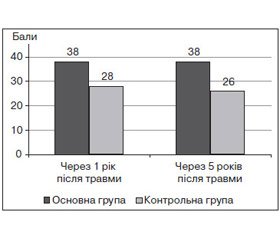Журнал «Травма» Том 16, №3, 2015
Вернуться к номеру
Results of treatment of patients with the proximal humerus fractures
Авторы: Strafun S., Bohdan S., Sergienko R., Makarov V. - SI "Institute of Traumatology and Orthopedics of NAMS of Ukraine", Kyiv
Рубрики: Травматология и ортопедия
Разделы: Клинические исследования
Версия для печати
Introduction. 4-5% of all fractures of the skeleton and 80% of the humerus fractures are fractures of the proximal part of humerus. The secondary (post-traumatic) osteoarthrosis of the shoulder joint that develops as a result of fractures of the proximal humerus makes up to 10% of the shoulder joint arthrosis regardless to treatment strategy. Most of authors evaluates the results of treatment of the proximal humerus fractures in one year after injury. Results of treatment of patients with this pathology in terms from one to five years or more - remain controversial or poorly investigated, although they are extremely important for the choice of treatment.
The purpose of this study was to evaluate the long-term results of treatment and to explore the development of secondary (posttraumatic) osteoarthrosis in patients with the proximal humerus fractures.
Materials and methods. We studied a group of 82 patients with fractures of the proximal humerus that were treated at the State Institution "Institute of Traumatology and Orthopedics of NAMS of Ukraine" from 2003 to 2010. The age of patients ranged from 27 to 68 years (average age 39,6 ± 9,1 years), men were 45 (54.87%), women - 37 (45.13%). All patients were divided into two groups depending on their treatment,. In the main group there were 42 (51.21%) patients after osteosynthesis with angular stability plates. In the control group there were 40 (48.79%) patients treated conservatively (immobilization and medications). Patients who had symptoms of osteoarthrosis of the shoulder joint at the time of injury or other injuries of the shoulder joint (rotator cuff tear, scapula labrum tear etc.) that could accelerate the development of osteoarthrosis of the shoulder joint or delay the beginning of rehabilitation of patients were excluded from study, that’s why we received statistically homogeneous groups. The universal classification of AO / ASIF was used to determine the type of fracture. All patients underwent a standard clinical and radiological examination. To identify other injuries of the shoulder joint MRI was used. Oxford Shoulder Score and Constant Shoulder Score were used to evaluate the function of the shoulder joint.
Results. In one year after injury, the average results of treatment of patients of the main group according to Oxford Shoulder Score were significantly better than in the control group (38 points - the main group, 28 points - control group), the same situation was observed after 5 years. On a Constant score, in one year after injury, number of patients with excellent and good results in the main group were greater than in the control group (30.5% excellent and good results - in the main group, 20.72% excellent and good results - in the control group). In 5 years after injury number of patients with excellent and good results in the main group was 32.92%, the number of excellent and good results in the control group was 19.49%. In one year after injury in patients who underwent surgery there were either no evidences of secondary omartrosis (7.34%) or radiographic changes were minimal (number of patients with osteoarthrosis of the shoulder joint stage 1-2 was 28,29% ). In the control group (conservative treatment) in one year after the injury the consequenses were considerably heavier and patients with secondary omarthrosis stage 3-4 dominated - 36.57%. In 5 years after injury in the main group the number of patients without secondary osteoarthrosis or omarthrosis of stages 1-2 were 39.02% in the control group - the vast number of patients were with severe arthrosis of the shoulder joint (arthrosis stage 3-4 in 39,04% of patients).
Conclusion. Contracture in the shoulder joint has a significant impact on the development of osteoarthrosis of the shoulder joint: a strong dependence (r = 0,72; p <0.01) revealed in the patients of the main group, patients in the control group revealed weak dependence of range of motions on the development of osteoarthrosis of the shoulder joint (r = 0,45; p <0.01).

